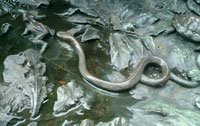 The dromedary or Arabian camel (Camelus dromedarius) was introduced in 1840 to the driest inhabited continent, Australia. As a beast of burden (images) it was to carry heavy loads and cross the dry and inhospitable lands. Their water-conserving abilities made them suitable as "draught and pack animals for exploration and construction of rail and telegraph lines; they were also used to supply goods to remote mines and settlements." Together with Muslim cameleers they pioneered inland routes of arid Australia from 1860s - 1930s.
The dromedary or Arabian camel (Camelus dromedarius) was introduced in 1840 to the driest inhabited continent, Australia. As a beast of burden (images) it was to carry heavy loads and cross the dry and inhospitable lands. Their water-conserving abilities made them suitable as "draught and pack animals for exploration and construction of rail and telegraph lines; they were also used to supply goods to remote mines and settlements." Together with Muslim cameleers they pioneered inland routes of arid Australia from 1860s - 1930s.The arrival of petrol powered motor vehicles in the 1920s made the work animal obsolete. Many were killed, but some escaped and prospered without predators. Today they are an invasive species in a desert ecosystem, constituting a threat to biodiversity.
 Anthropogenic climate changes, permanent drought and increasing desertification are a stress for settlers, their stock, wildlife and feral animals. The camels are seeking the watering places where humans and their stock have settled. They are "tearing down fences and smashing troughs to get at water.""Camels are also an increasing hazard to motorists traversing outback roads."
Anthropogenic climate changes, permanent drought and increasing desertification are a stress for settlers, their stock, wildlife and feral animals. The camels are seeking the watering places where humans and their stock have settled. They are "tearing down fences and smashing troughs to get at water.""Camels are also an increasing hazard to motorists traversing outback roads."They are to be culled in national parks and on pastoral leases. It will cost AS $19m to fire at them from helicopters, as was done in the aerial predator control programme shooting wolfs in the same way. Contraceptives are thought of as too ineffective as they would still have time to trample vegetation. Selling the meat in controlled harvest is also thought of as not feasible.
There is no doubt, invasive species have to be limited or eradicated from Australia, but is this method the most appropriate one?
Questions remain:
What is being done about live stock 'trampling' water courses and National Parks etc?
What is being done about epidemic populations of dogs and cats going feral?
What is being done about selling exotic flora and fauna?
What is being done about smuggling exotic flora and fauna?
What is being done about peak oil mobility in a desert environment?
What is being done about the many off-road vehicles in the 'outback', 'trampling' the landscape and biodiversity?
Camel season opens in Australia, The Great Beyond August 12, 2009
Update:
Another 60,000 feral camels from Central Australia will be culled through aerial shooting abc 05082010
Images:
Pisanello, Dromedary, 1425–1450 via Zeno
Camel, Abû Sa'îd 'Ubaydallâh ibn Bakhtîshû, Persian Master, 1297-1299, via Zeno








No comments:
Post a Comment